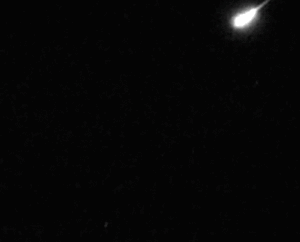A few days ago there was a spate of telephone calls received at police stations in the north of England and in Scotland. People were reporting seeing a very bright object moving across the night sky and it left a long illuminated tail in its wake. I suppose they had thought they had seen an alien craft but in fact it was merely a meteor, specifically a ‘bolide’, that is a meteor which is usually very bright as described with a long trailing tail. These meteors tend to explode after a few seconds in the atmosphere. The reason they explode is due to the extreme speed and its mass. The long bright trail is caused by the low angle of entry thus allowing it to take longer in descent. For them to burn up in the atmosphere for so long depends on both its mass and its angle of entry. For those of us familiar with the night sky these events are pretty much commonplace. Meteors are, it is thought, the remains of comets or debris from comets left in their orbits. Some comets orbit the Sun in near circular paths whilst others orbit in very much elongated elliptical paths. Other comets are random visitors to our Solar System and will make only one pass and never again return. The debris left in these orbits ranges in size from dust particles to rocks several metres in diameter. The larger ones can and occasionally do reach the ground or fall into the oceans. They are then referred to as meteorites. Extremely large meteors are rare but there have been quite a few in the Earths history, Meteor Crater in Arizona is one notable result of such a collision. Most meteors simply burn up long before they can reach the surface. There are quite a number of these meteor ‘showers’ occurring throughout the year and the more well-known happen at the same time each year as the Earth passes through the various debris orbits. Our path around the Sun is not completely clear and the Earth is bombarded by this debris very often. Larger objects such as asteroids and comets would do much damage to our environment should we ever collide with them. There have been many close encounters in the past some of which have resulted in a collision but fortunately for us they are extremely rare. The Solar System is much ‘cleaner’ than it was millions of years ago. The danger is always there though. Most evenings when it is dark and clear the occasional meteor can be spotted but when a particular shower is imminent many more can be seen. It is getting more difficult to see the night sky because of the light pollution we produce but there are still many places where the sky is relatively clear and the opportunity to see a meteor or two is possible for those patient enough to wait. Bolides are difficult to miss!
Shirley Anne
Related articles
- Meteor witnessed across Britain – BBC News (bbc.co.uk)
- Meteor lights up the sky across England – Daily Mail (dailymail.co.uk)
- Meteor ‘fireball’ spotted in night sky across UK (guardian.co.uk)
- Meteor streaks across the U.K (disclose.tv)

